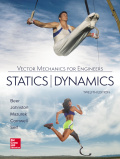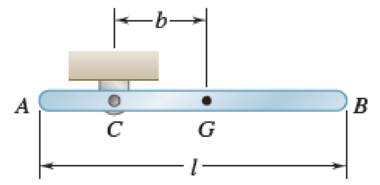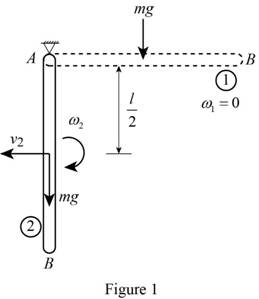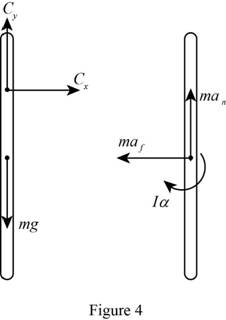
Concept explainers
A slender rod of length l and mass m is pivoted about a point C located at a distance b from its center G. It is released from rest in a horizontal position and swings freely. Determine (a) the angular velocity of the rod as it passes through a vertical position if b = l/2, (b) the distance b for which the angular velocity of the rod as it passes through a vertical position is maximum, (c) the corresponding values of its angular velocity and of the reaction at C using the value of b calculated.

Fig. P17.16
(a)
Find the angular velocity of the rod when
Answer to Problem 17.16P
The angular velocity of the rod when
Explanation of Solution
Show the free-body diagram of the given condition as in Figure 1.

Find the mass moment of inertia of the slender rod
Here, the mass of the slender rod is m and the length of the slender rod is l.
Position 1 (Horizontal position):
The angular velocity
The velocity
Find the total kinetic energy in the horizontal position
Substitute 0 for
Positon 2 (Vertical position):
Find the velocity of the slender rod
Find the total kinetic energy in the vertical position
Substitute
Find the work done
Here, the acceleration due to gravity is g.
Write the equation of work and energy for the system using the equation.
Substitute 0 for
Therefore, the angular velocity of the rod when
(b)
Find the distance b for which the angular velocity of rod as it passes through a vertical position is maximum.
Answer to Problem 17.16P
The distance b for which the angular velocity of the rod is maximum in vertical position is
Explanation of Solution
Position 1 (Horizontal position):
Show the free-body diagram of the horizontal position as in Figure 2.

Find the mass moment of inertia of the slender rod
The angular velocity
The velocity
Find the total kinetic energy in the horizontal position
Substitute 0 for
The elevation (h) of the pivot C is zero.
Find the total potential energy
Substitute 0 for h.
Positon 2 (Vertical position):
Show the free-body diagram of the vertical position as in Figure 3.

Find the velocity of the slender rod
Find the total kinetic energy in the vertical position
Substitute
The elevation of the pivot C is
Find the total potential energy
Substitute b for h.
Write the equation of conservation of energy using the equation.
Substitute 0 for
Integrate the angular velocity with respect to b and equate to zero.
Therefore, the distance b for which the angular velocity of the rod is maximum in vertical position is
(c)
Find the angular velocity where the vertical position is maximum and the reaction at pivot C.
Answer to Problem 17.16P
The angular velocity corresponding to the maximum vertical position is
The reaction at pivot C is
Explanation of Solution
Refer to the calculation of part (b):
Substitute
Therefore, the angular velocity corresponding to the maximum vertical position is
Show the free-body diagram of the slender rod as in Figure 4.

Find the normal acceleration
Substitute
The value of tangential acceleration is
Resolve the vertical component of forces.
Take moment about point C as follows;
Therefore,
Resolve the horizontal component of forces.
Find the resultant reaction at point C using the relation.
Substitute 0 for
Therefore, the reaction at pivot C is
Want to see more full solutions like this?
Chapter 17 Solutions
Vector Mechanics for Engineers: Statics and Dynamics
Additional Engineering Textbook Solutions
Thinking Like an Engineer: An Active Learning Approach (3rd Edition)
HEAT+MASS TRANSFER:FUND.+APPL.
Fundamentals Of Thermodynamics
Statics and Mechanics of Materials
Thinking Like an Engineer: An Active Learning Approach (4th Edition)
DESIGN OF MACHINERY
- A slender 9-lb rod can rotate in a vertical plane about a pivot at B. A spring of constant k = 30 lb/ft and of unstretched length 6 in. is attached to the rod as shown. Knowing that the rod is released from rest in the position shown, determine its angular velocity after it has rotated through 90°.arrow_forwardA long ladder of length l, mass m, and centroidal mass moment of inertia I is placed against a house at an angle 0=0O. Knowing that the ladder is released from rest, determine the angular velocity of the ladder when 0=02. Assume the ladder can slide freely on the horizontal ground and on the vertical wall.arrow_forwardDisks A and B are made of the same material, are of the same thickness, and can rotate freely about the vertical shaft. Disk B is at rest when it is dropped onto disk A, which is rotating with an angular velocity of 500 rpm. Knowing that disk A has a mass of 8 kg, determine (a ) the final angular velocity of the disks, (b ) the change in kinetic energy of the system.arrow_forward
- Each of the gears A and B has a mass of 675 g and a radius of gyration of 40 mm, while gear C has a mass of 3.6 kg and a radius of gyration of 100 mm. Assume that kinetic friction in the bearings of gears A, B C produces couples of constant magnitude 0.15 N.m, 0.15 N.m, 0.3 N.m, respectively. Knowing that the initial angular velocity of gear C is 2000 rpm, determine the time required for the system to come to rest.arrow_forwardDisk A, of weight 10 lb and radius r = 6 in., is at rest when it is placed in contact with belt BC, which moves to the right with a constant speed v = 40 ft/s. Knowing that μk = 0.20 between the disk and the belt, determine the number of revolutions executed by the disk before it attains a constant angular velocity.arrow_forwardIn the gear arrangement shown, gears A and C are attached to rod ABC, that is free to rotate about B, while the inner gear B is fixed. Knowing that the system is at rest, determine the magnitude of the couple M that must be applied to rod ABC, if 2.5 s later the angular velocity of the rod is to be 240 rpm clockwise. Gears A and C ABC weighs 4 lb.arrow_forward
- The mechanism shown is one of two identical mechanisms attached to the two sides of a 200-lb uniform rectangular door. Edge ABC of the door is guided by wheels of negligible mass that roll in horizontal and vertical tracks. A spring with a constant k is attached to wheel B in such a way that its tension is zero when 0 = 30°, Knowing that the door is released from rest in the position 0 = 45° and reaches the vertical position with an angular velocity of 0.6 rad/s, determine the spring constant k.arrow_forwardA rod of uniform cross section is used to form the shaft shown. Denoting by m the total mass of the shaft and knowing that the shaft rotates with a constant angular velocity w, determine (a ) the angular momentum HG of the shaft about its mass center) the angle formed by HG and the axis AB, (c) the angular momentum of the shaft about point A.arrow_forwardA uniform 144-lb cube is attached to a uniform 136-lb circular shaft as shown, and a couple M with a constant magnitude is applied to the shaft when the system is at rest. Knowing that r = 4 in., L= 12 in., and the angular velocity of the system is 960 rpm after 4 s, determine the magnitude of the couple M.arrow_forward
- The rotor of an electric motor has an angular velocity of 3600 rpm when the load and power are cut off. The 120-lb rotor, which has a centroidal radius of gyration of 9 in., then coasts to rest. Knowing that kinetic friction results in a couple of magnitude 2.5 lb·ft exerted on the rotor, determine the number of revolutions that the rotor executes before coming to rest.arrow_forwardA uniform rod of mass m and length 5 a is bent into the shape shown and is suspended from a wire attached at point B. Knowing that the rod is hit at point A in the negative y direction and denoting the corresponding impulse by determine immediately after the impact (a) the velocity of the mass center G, (b) the angular velocity of the rod.arrow_forwardA slender 9-lb rod can rotate in a vertical plane about a pivot at B. A spring of constant k = 21 lb/ft and of unstretched length 6 in. is attached to the rod as shown in the figure. Knowing that the rod is released from rest in the position shown in the figure, determine its angular velocity after it has rotated through 90 degree .arrow_forward
 Elements Of ElectromagneticsMechanical EngineeringISBN:9780190698614Author:Sadiku, Matthew N. O.Publisher:Oxford University Press
Elements Of ElectromagneticsMechanical EngineeringISBN:9780190698614Author:Sadiku, Matthew N. O.Publisher:Oxford University Press Mechanics of Materials (10th Edition)Mechanical EngineeringISBN:9780134319650Author:Russell C. HibbelerPublisher:PEARSON
Mechanics of Materials (10th Edition)Mechanical EngineeringISBN:9780134319650Author:Russell C. HibbelerPublisher:PEARSON Thermodynamics: An Engineering ApproachMechanical EngineeringISBN:9781259822674Author:Yunus A. Cengel Dr., Michael A. BolesPublisher:McGraw-Hill Education
Thermodynamics: An Engineering ApproachMechanical EngineeringISBN:9781259822674Author:Yunus A. Cengel Dr., Michael A. BolesPublisher:McGraw-Hill Education Control Systems EngineeringMechanical EngineeringISBN:9781118170519Author:Norman S. NisePublisher:WILEY
Control Systems EngineeringMechanical EngineeringISBN:9781118170519Author:Norman S. NisePublisher:WILEY Mechanics of Materials (MindTap Course List)Mechanical EngineeringISBN:9781337093347Author:Barry J. Goodno, James M. GerePublisher:Cengage Learning
Mechanics of Materials (MindTap Course List)Mechanical EngineeringISBN:9781337093347Author:Barry J. Goodno, James M. GerePublisher:Cengage Learning Engineering Mechanics: StaticsMechanical EngineeringISBN:9781118807330Author:James L. Meriam, L. G. Kraige, J. N. BoltonPublisher:WILEY
Engineering Mechanics: StaticsMechanical EngineeringISBN:9781118807330Author:James L. Meriam, L. G. Kraige, J. N. BoltonPublisher:WILEY





